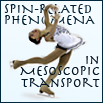Speaker
Carlo Canali
Description
State-of-the-art STM techniques have made it possible to
substitute transition metal impurities for individual atoms
in semiconductor crystals and have provided detailed
information on the nature of the bound acceptor or donor
states. Individual coupled acceptor (or donor)-impurity
centers represent a new class of nanomagnets which we refer
to as acceptor or donor magnets. In this talk I will
present results of the electronic and magnetic properties of
these nanomagnets, based on a recently introduced
tight-binding method [1] that is able to capture the salient
features of Mn atoms near the (110) GaAs surface. The
effective total spin J of local moments formed from acceptor
states bound to Mn ions in GaAs is identified with a
topological Chern number, given by the integral of a Berry
curvature functional over all possible magnetic moment
directions. When individual Mn atoms are close to the sample
surface, the total spin changes from J=1 to J =2, due to
quenching of the acceptor orbital moment. For Mn pairs in
bulk, the total J depends on pair orientation in the GaAs
lattice and on the separation between the Mn atoms. We point
out that Berry curvature variations as a function of local
moment orientation can profoundly influence the quantum-spin
dynamics of these magnetic entities.
Work was done in collaboration with T. O. Strandberg and A. H. MacDonald.
[1] T. O. Strandberg, C. M. Canali, A. H. MacDonald, Phys. Rev. B 80, 024425, (2009).
Work was done in collaboration with T. O. Strandberg and A. H. MacDonald.
[1] T. O. Strandberg, C. M. Canali, A. H. MacDonald, Phys. Rev. B 80, 024425, (2009).

